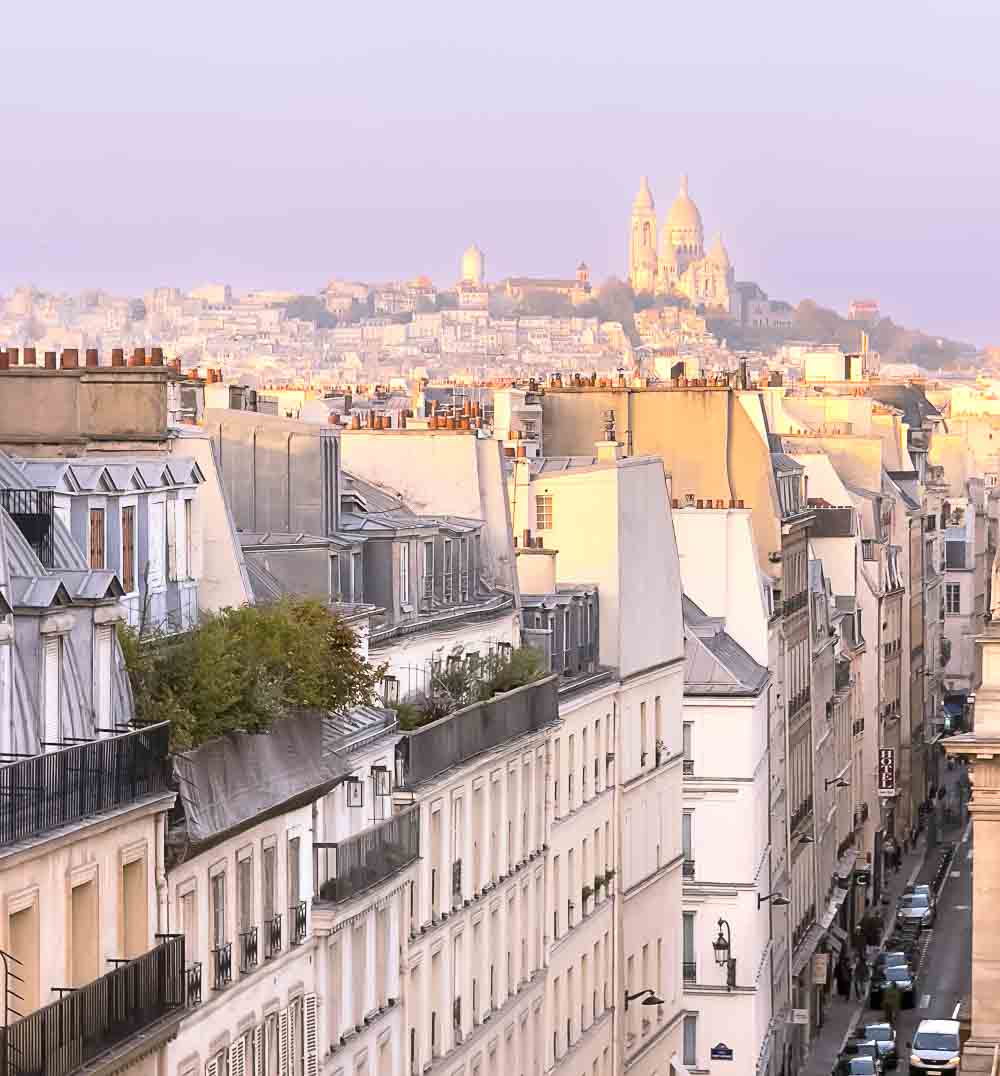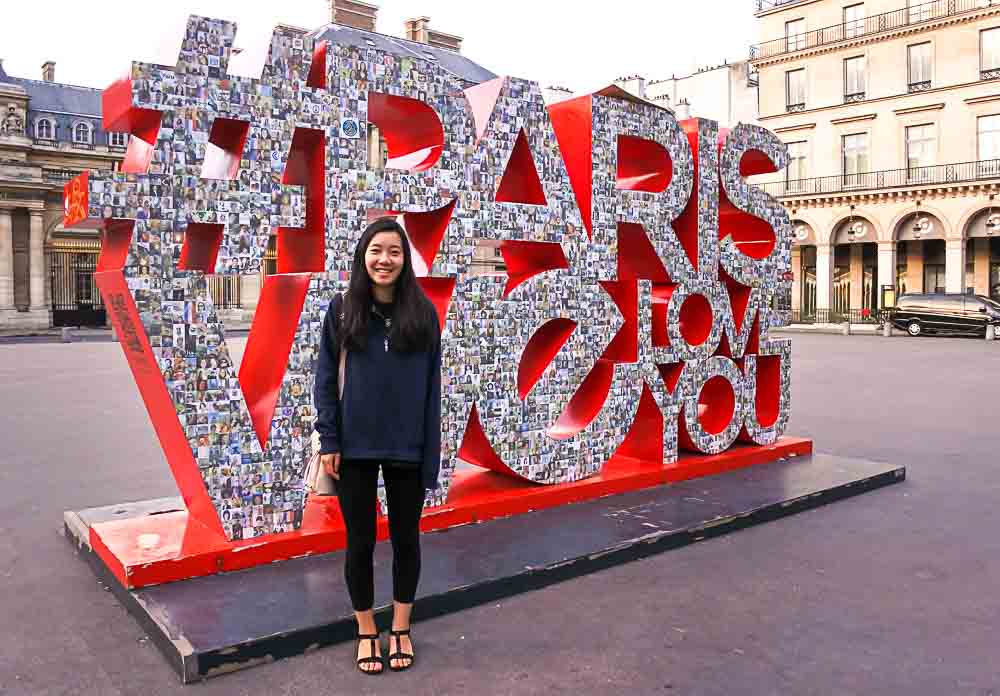Are you wondering if you should take a guided tour of the Louvre Museum when you visit Paris? Or book a reserved timed-entrance ticket in advance?
For a lot of visitors, especially if you're visiting for the first time, the best, fastest, and easiest way to explore the Louvre, view its iconic treasures such as Leonardo da Vinci's Mona Lisa, and bypass the notoriously long ticket and general-admission security lines is to join a guided tour.
That's what I usually do, even though I've visited the Louvre many times. I never regret learning new things from an expert guide, but I do regret the hours I've wasted in the past standing in lines.
To be clear: you do still have to go through a security check on a tour, but tour groups get to use a special tour-only entrance so there's usually little-to-no wait.
Book Your Louvre Museum Entrance Now
- Louvre Masterpieces Tour with Reserved Tickets - Most popular choice
- Louvre Museum Skip-the-Line Guided Tour - Small group tour (this is the one I usually choose)
- Priority Access with Host - Direct to Mona Lisa - A "host" escorts you through the tours-only expedited entrance and leads you straight to Da Vinci's famous painting
- Louvre Museum Tour with Mona Lisa & Iconic Masterpieces - Usually a larger group experience but highly rated and popular
- Louvre Museum Timed-Entry Ticket - Ticket only, with expedited entrance
Even though a timed-entrance ticket (the last choice on the list above) doesn't get you in through the faster guided-tour only entrance, it still lets you avoid the long ticket lines which means that you get to go through a special, faster line.
It's non-refundable, unlike most of the guided tours which (typically) let you cancel up to 24 hours in advance, so keep that in mind when booking.
Although the Louvre now limits daily admission to 30,000 visitors (down from 45,000/day a couple of years ago), that's still a lot of people crowding around the most popular exhibits. Tours led by the expert licensed guides provide plenty of benefits to help you get the most from your visit.
Being part of a tour group means you get fast-track priority entrance into the museum, the expertise of someone who knows where the most famous masterpieces are located and how to whisk you quickly through the masses of other visitors to get to them, and insights and interesting stories about the art that make the whole experience a richer experience.
As a bonus, most tours let you continue exploring on your own after the tour ends.
In this article, I provide tips on how to choose the best Louvre tours, how the skip-the-line process works, highlights of what you might see on a guided tour (or might consider seeing if you go on your own), and a few more things to see and do in the museum and nearby Paris locations after your official tour ends.
More Ways to See the Louvre Museum:
Article Contents
- What to Expect on a Guided Tour of the Louvre
- What Types of Exhibits Will You See at the Louvre Museum? Mona Lisa & So Much More!
- What Else Can You Do in the Louvre?
- Where to Stay near the Louvre
Top photo: Pyramid and reflecting pool in front of the Louvre, (c) Paris Discovery Guide
Paris Discovery Guide is a reader-supported publication. When you buy through my links, I may earn a small commission at no additional cost to you. Merci beaucoup for your support!
What to Expect on a Guided Tour of the Louvre
How to Choose the Right Tour Based on Your Preferences
Tour booking platforms such as Get Your Guide and Viator offer a huge variety of Louvre Museum tours - in fact, the choices can be overwhelming. Which are the best Louvre tours for you to consider? First, think about the kind of experience you want to get from your tour.
If you want to be able to hear your guide and perhaps ask questions, I strongly recommend booking a small group tour vs one of the larger-group tours.
Although the Louvre's baseline for tour groups limits them to just 6 people plus the guide in order to minimize disruption to other visitors, tour companies can bring in much larger groups by paying an additional fee - which is why you'll sometimes see huge groups of 25 or more people struggling to hear their guide through headsets.
To avoid this kind of experience, look for tours with "small group" in the tour description and check the maximum group size. Even some small group tours may include up to 12 people - so read the fine print in the descriptions.
If you have limited time and are looking for a faster-paced experience where you won't be doing quite as much walking or if all you want to see is the Mona Lisa painting, here a couple more highly-rated non-small group options:
- Must-Sees of the Louvre Museum: 1.5 Hour Guided Tour - Skip the lines and see the Mona Lisa, Winged Victory, Venus de Milo, and other famous masterpieces on this whirlwind "Top 10" (or more) tour - usually available in two formats: small group and large group
- Priority Access with Host - Direct to Mona Lisa - Perfect for fast entrance and a path to the famous painting; you can then continue exploring on your own, or leave and go on to other activities
If you'd prefer a private tour for just you and whoever you bring with you, the Louvre Museum Skip-the-Line Access Private Guided Tour pairs you with an expert guide who will speed you through the entrance, show you iconic masterpieces and lesser-known gems, and give you an unforgettable V.I.P. experience while sharing fascinating information about what you see.
Visiting the Louvre with children or teens? Consider a private tour designed for families. The cost for a family of up to 5 people compares favorably with a small group tour, and you get the advantage of a guide with expertise in keeping kids engaged and entertained by the art while giving the adults an informative and (best of all, speaking as a mom) a relaxing experience.
How Skip-the-Line Access Works for Guided Tours
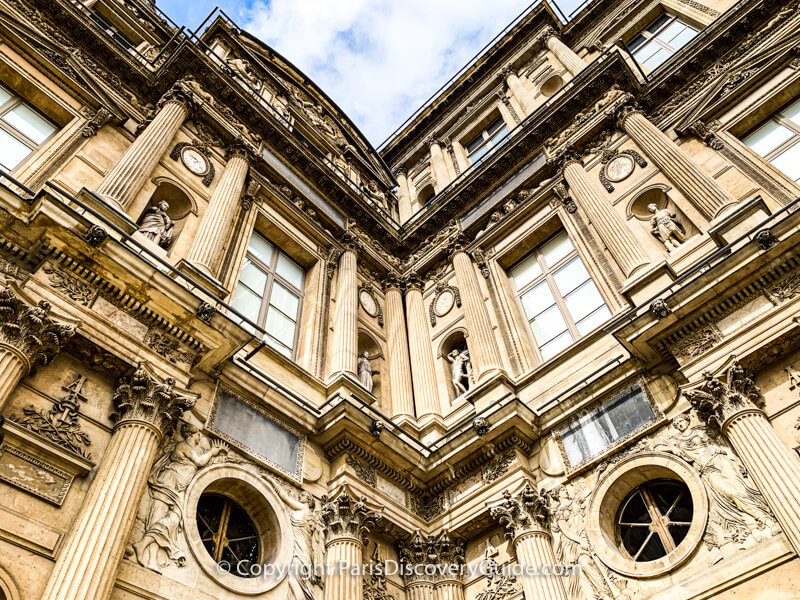
Meeting Your Tour Group
When you book your small group or private tour, you'll receive instructions about where to meet up with your guide.
Most tours meet at a designated spot such as in front of one of the Paris souvenir stores on Rue de Rivoli, which runs along the Louvre's north side. You'll be given the name of the store and the address when you book your tickets.
What to Expect When Your Guide Arrives
At the designated time, your guide will arrive, make introductions, and verify that everyone is present. You'll walk together to the Louvre.
All tours include tickets to the Louvre for a specific time slot. If your group arrives a few minutes early, your guide may give you a brief orientation to the Louvre's ornate exterior architecture.
Up close, the Louvre is so enormous and ornate that it feels almost overwhelming and slightly incomprehensible - yet your guide can quickly explain the architectural styles, ornamentation, and even the symbolism of a few of the statues and carvings while filling you in on the building's origin as a fortress and then a fortified castle begun in 1190 by Phillip-Auguste, its evolution and reconstruction as a royal palace in the 14th century, and its conversion during the French Revolution to become the French national gallery and museum.
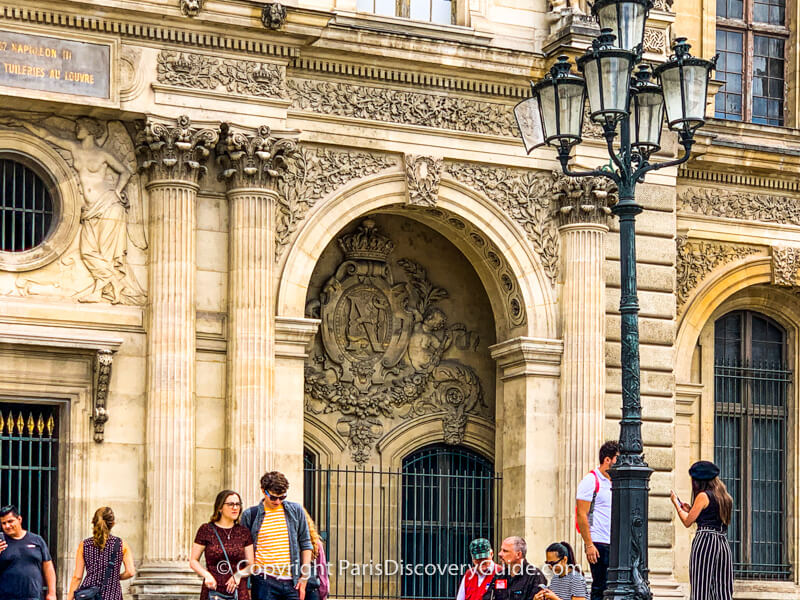
Next, you'll go walk around to the building's western and slightly newer facade, where you'll pass through security and enter the museum.
Skipping the Long Security Lines & Getting Priority Access through a Group Tour Entrance
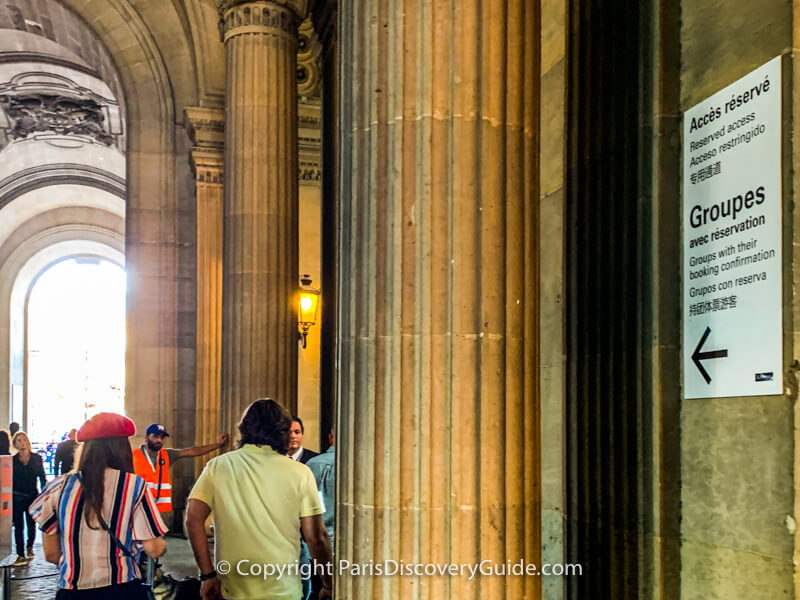
Most groups head down a special tour group-only entrance through the Richelieu Passage - a broad hall with ornate vaulted ceilings and lined with arcades and expanses of glass giving you glimpses into the museum.
After making a quick turn through a specially marked group entrance and walking down a short flight of stairs, you'll pass through a security checkpoint where you have to open our bags for a quick inspection.
Normally there's no line at all. It's a total breeze compare to going through the much, much busier public entrance at the Pyramid in the museum's courtyard or through the Carrousel du Louvre shopping mall.
After passing through the checkpoint, you'll almost immediately enter a large group reception room with an opportunity you should not miss: uncrowded restrooms.
From there, you'll pass through another door and walk out onto the museum's vast entry hall on the "Level 0" floor under the pyramid. Again, totally fast and easy.
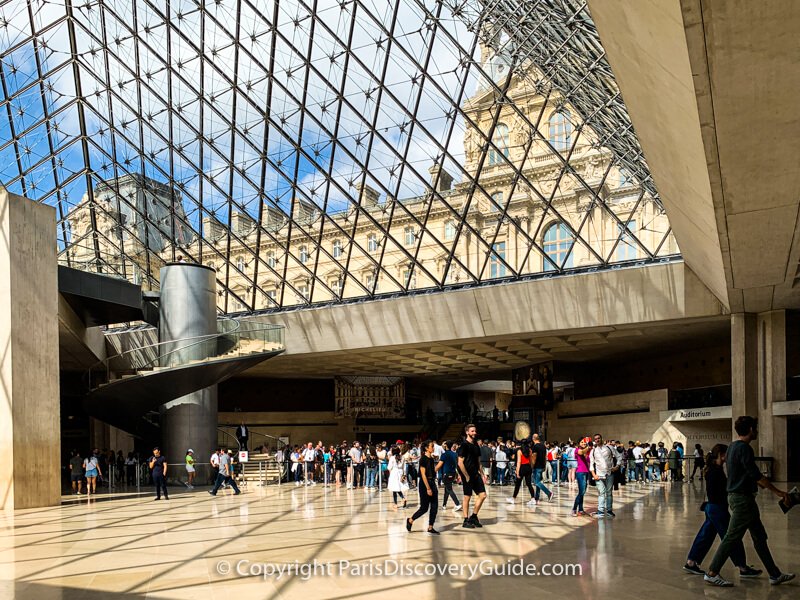
What Types of Exhibits Can You See at the Louvre Museum?
With so many different tour options for seeing the Louvre with a guide, it is impossible to predict exactly what you will experience - but in general, most group tours take you to see several of the most famous masterpieces such as Leonardo da Vinci's Mona Lisa painting, Greek sculptures such as the Venus de Milo and Winged Victory of Samothrace, plus rooms containing massive French paintings such as Delacroix's Liberty Leading the People.
You may also visit the Pavillon de l'Horloge where you can see the museum's medieval foundations and moat, bits of one or two other collections, such as the Egyptian Galleries in the Sully Wing, the French Royal crown jewels in the breathtaking Apollo Gallery, and possibly Napoleon III's sumptuous apartments. And don't forget that along the way, you can see some of the museum's most breathtaking treasures simply by looking up.
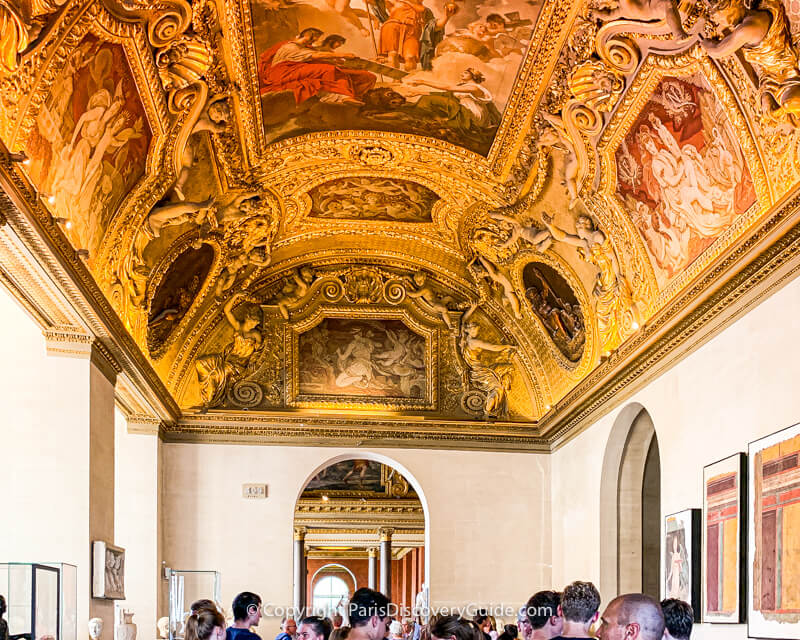
In small group tours such as the Louvre Museum Skip-the-Ticket-Line Guided Tour, guides have the flexibility of somewhat customizing the itinerary to suit your group's interests.
Even if the museum is packed with other visitors on the day of your tour, your guide will help you dodge the masses to prevent you from feeling jostled and will also position you to have excellent views of the art.
And because guides know all the museum's short cuts and hidden stairways, they'll get you from one exhibit to the next much faster than you could navigate on your own.
After after you pass through security and under the Pyramid on the ground floor, your guide will take you up an escalator to Level 1 and may point out the museum's three wings: Sully, Richmond, and Denon.
Each wing has an entrance where where you will scan your ticket in order to enter. Occasionally you may encounter a short line, but even if you do, the entrance process normally takes less than a minute.
Each time you move from one wing to another through this central entry hall, you will need to show your ticket, although you can also go from wing to wing by winding your way through the galleries.
So, what will you see? Here are exhibits that may be included, although keep in mind: they may differ based on museum conditions (such as crowds), the tour guide's preference, your group's interests, and the length of your tour.
The Mona Lisa & Other Italian Renaissance Masterpieces
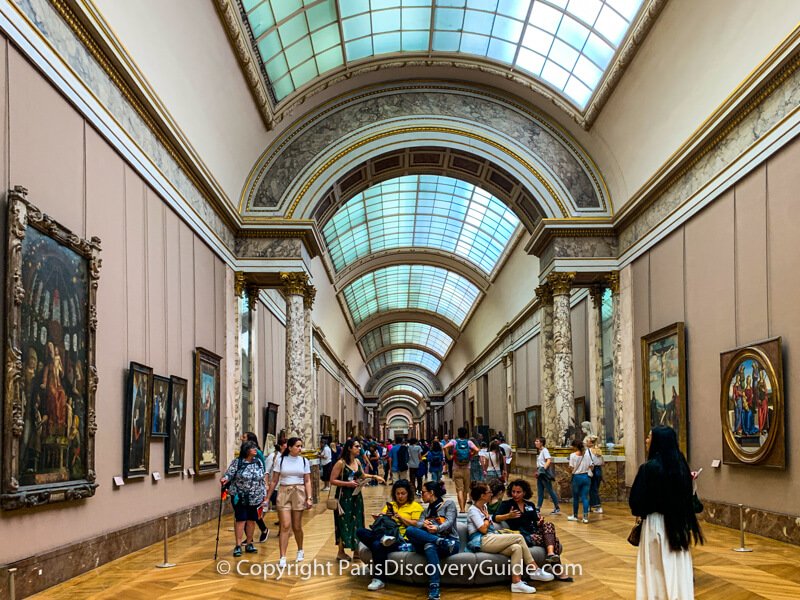
On the way to see Leonardo da Vinci's famous Mona Lisa in the Denon Wing, your guide may take you through the Grande Galerie filled with stunning Italian Renaissance masterpieces by Titian, Raphael, da Vinci, and others, pausing to linger in front of some of the most stunning.
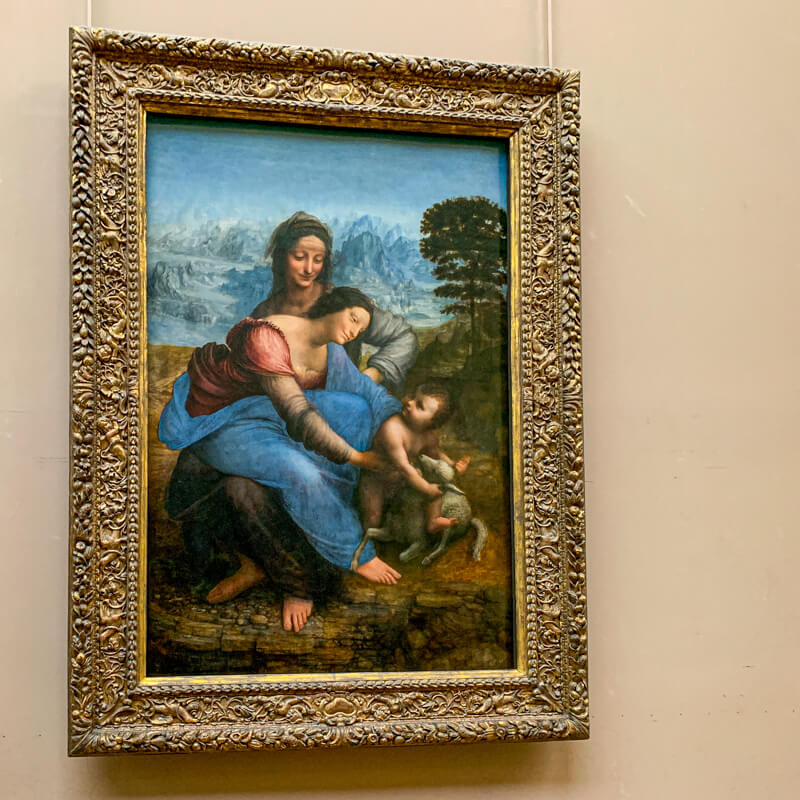
The Louvre has the largest collection of da Vinci paintings in the world, and your guide may point out some of them along the way.
The Louvre's most famous painting of all, da Vinci's Mona Lisa, his portrait of Lisa Gherardini, wife of a Florentine merchant, holds center stage in a gallery lined with other wonderful Italian paintings but they get mostly ignored.
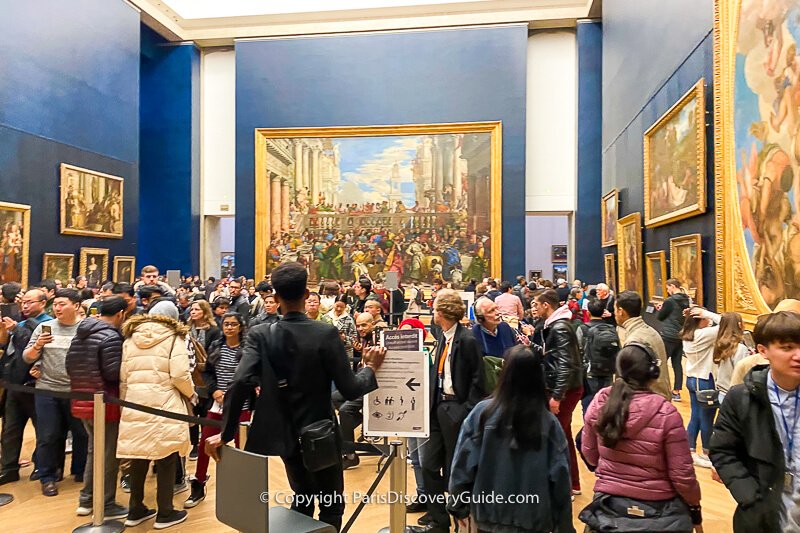
The massive lines of people focus only on trying to glimpse La Jaconde, as the famous painting is known in Italian.
Because of the crowds, the museum guards keep the lines moving as quickly as possible.
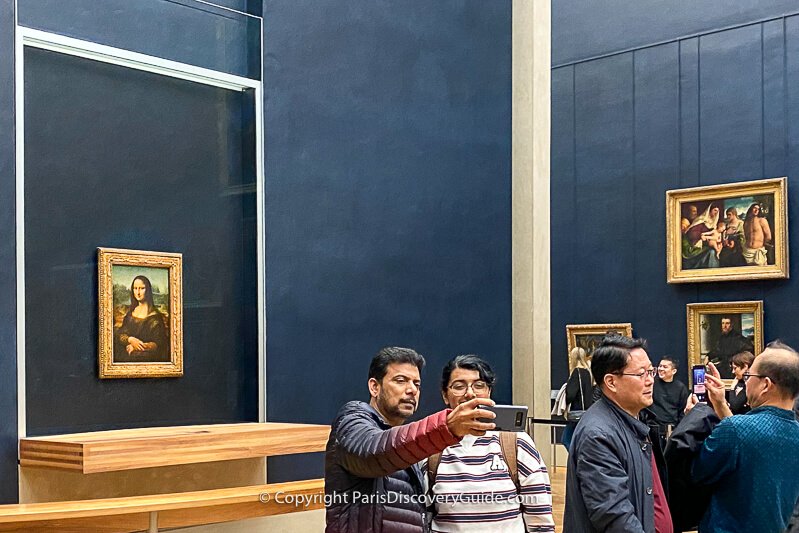
Once you reach the front, you get 15-30 seconds in front of the Mona Lisa, which most people use to take a selfie.
Occasionally, if the wait is too long, the tour guide may suggest that you see the painting on your own afterwards, which is usually a good idea because you're not wasting tour time by standing in line, plus this gives you the option to skip it.
Although there is a certain thrill about seeing this iconic artwork in person, let's face it - we've all seen so many photos of the painting that we already know what it looks plus it's not that easy to see, thanks to the thick protective glass encasing it and the ropes that keep us at a distance.
Want to See Only the Mona Lisa?
Museum officials estimate that up to 40% of all visitors see only one piece of art at the museum: the Mona Lisa.
If that's you or if you don't have enough time to see more than this one masterpiece, you may want to check out a quick Only the Mona Lisa experience. Your guide will whisk you through security as you skip the entrance line and take you directly to the line to see the famous portrait, which will usually save you some time and perhaps frustration compared with finding it on your own. Please note: this is not a guided tour.
Another alternative, of course, is to get a priority entrance ticket (or use a Museum Pass) and come on your own.
Venus de Milo, Winged Victory, Cupid's Kiss, & Other Greek Antiquities
The Louvre's immense and always-popular Greek Antiquities Gallerie contains some of the world's most famous sculptures from this period.
You are likely to see the three most famous sculptures - Venus de Milo, the Winged Victory of Samothrace, and Psyche Revived by Cupid's Kiss - and hear about the myths and legends embodied by the art.
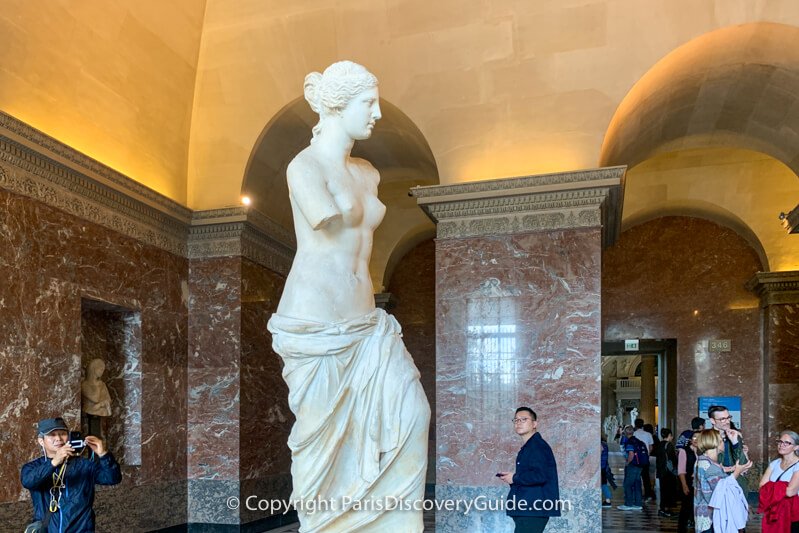
At the sculpture of Venus de Milo, your guide may share information about why the statue is missing its arms.
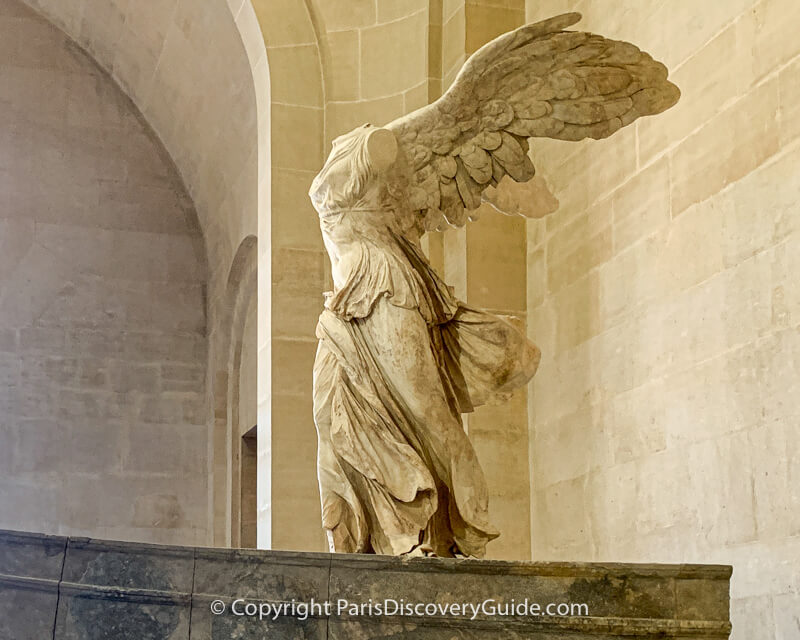
Even if the Winged Victory of Samothrace statue of Nike, Goddess of Victory, is surrounded by large tour groups, your guide may position your group so that you can see the statue from all sides.
Look closely at the sculpture's details. Which viewing angle do you think its creator might have had in mind?
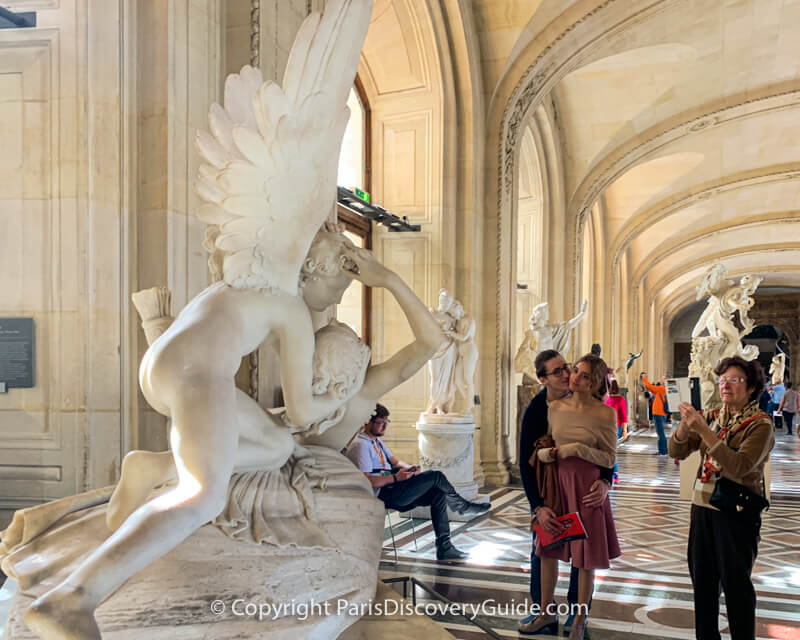
Of course, there's a lot more to see in these galleries beyond just the famous statues. If you're on the 3-hour tour, your guide may show you other favorites. If not, you can always return on your own after the tour ends.
The Great Sphinx in the Louvre's Egyptian Antiquities Gallery
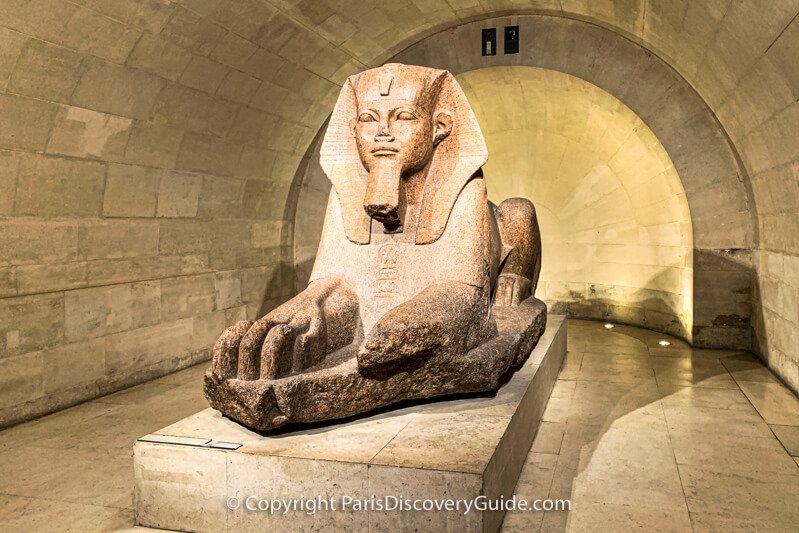
The Louvre's Egyptian Antiquities Gallery is huge - another area where hours can pass like a heartbeat as you admire the extensive collection of mummies and other artifacts.
Most tours pause only long enough to examine the magnificent Great Sphinx of Tanis, sculpted from granite possibly as long ago as the Old Kingdom period in 2600 BC. With the head of a king and the body of a lion, the sculpture is over 5 feet long and carefully crafted with precise details. If you're going to see only one thing in this fascinating gallery, the sphinx is a fantastic choice.
Medieval Art in the Italian Galleries
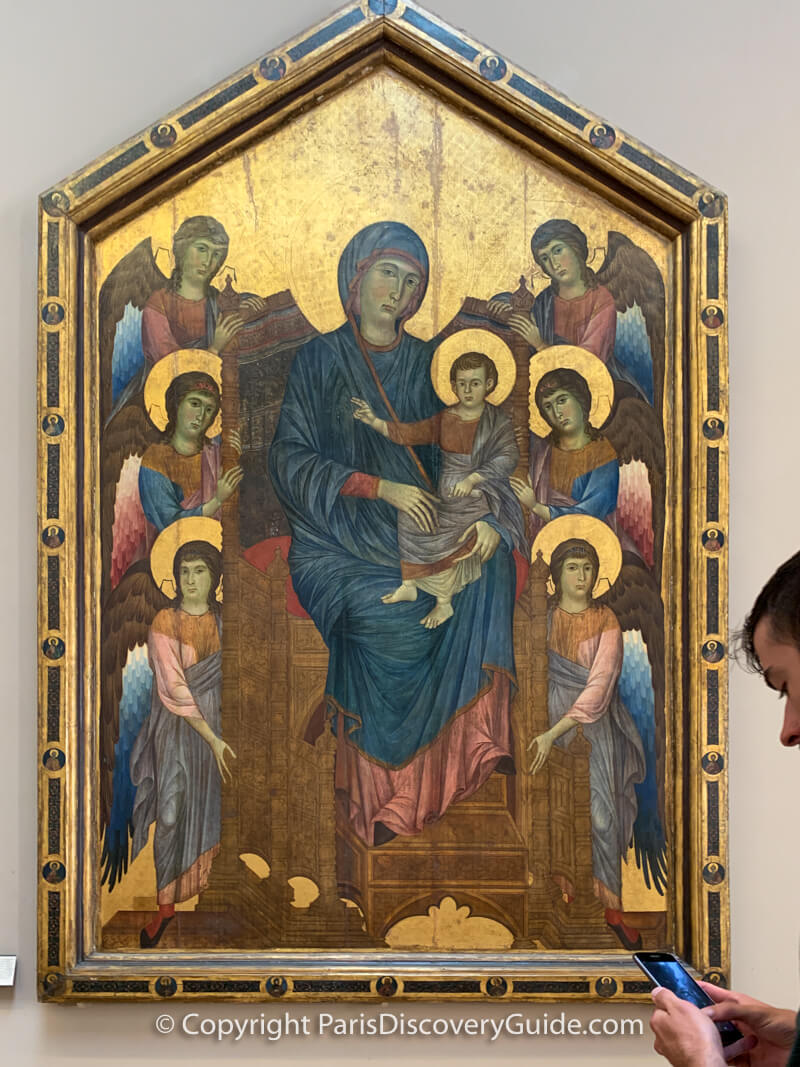
Some tours may pause briefly in the room with medieval Italian paintings where the guide might give a mini-lesson about how art (and painters' skills) changed between the Medieval and Renaissance periods.
For example, look at the beautiful Madonna and Child painting by Florentine artist Cimabue (above). What aspects do you find striking or unusual from a 21st century perspective?
Famous French Paintings
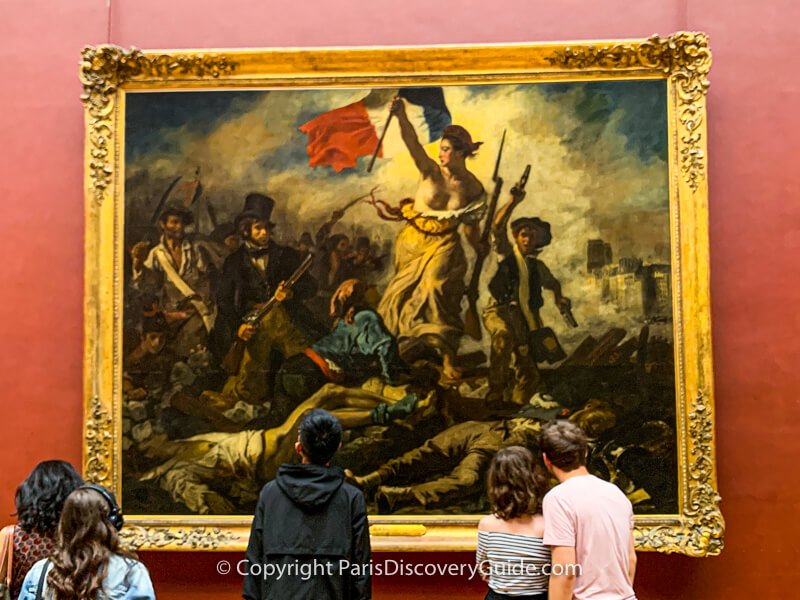
Most tours stop by the French Paintings Gallery, which features huge canvases by famous 18th and 19th century French painters depicting important moments in French history. Unless you happen to know a LOT about the details of French history, these paintings can be hard to fully appreciate.
This is where your guide's expertise can help these paintings come alive. For example, one of the most famous of these paintings, Delacroix's Liberty Leading the People, can be hard to fully appreciate - but a knowledgeable guide can quickly and succinctly explain the historical, revolutionary, and philosophical details depicted in the painting and also point out the symbolism, allegorical references, and other nuances.
Perhaps best of all, your guide will do this in a lively and entertaining way - a useful skill when you're trying to explain a painting about the July Revolution of 1830 (no, that is not the French Revolution triggered by the storming of the Bastille in 1789 - it was a second but also important revolution against the monarchy) to a tour group of non-French people.
Apollo Gallery (Galerie d'Apollon)
The Galerie d'Apollon is without a doubt one of the museum's most exquisite rooms.
Gilded walls, superb tapestries, a fantastically embellished vaulted ceiling, and more ornamentation than you can imagine provides the perfect setting for display the French Crown Jewels collection.
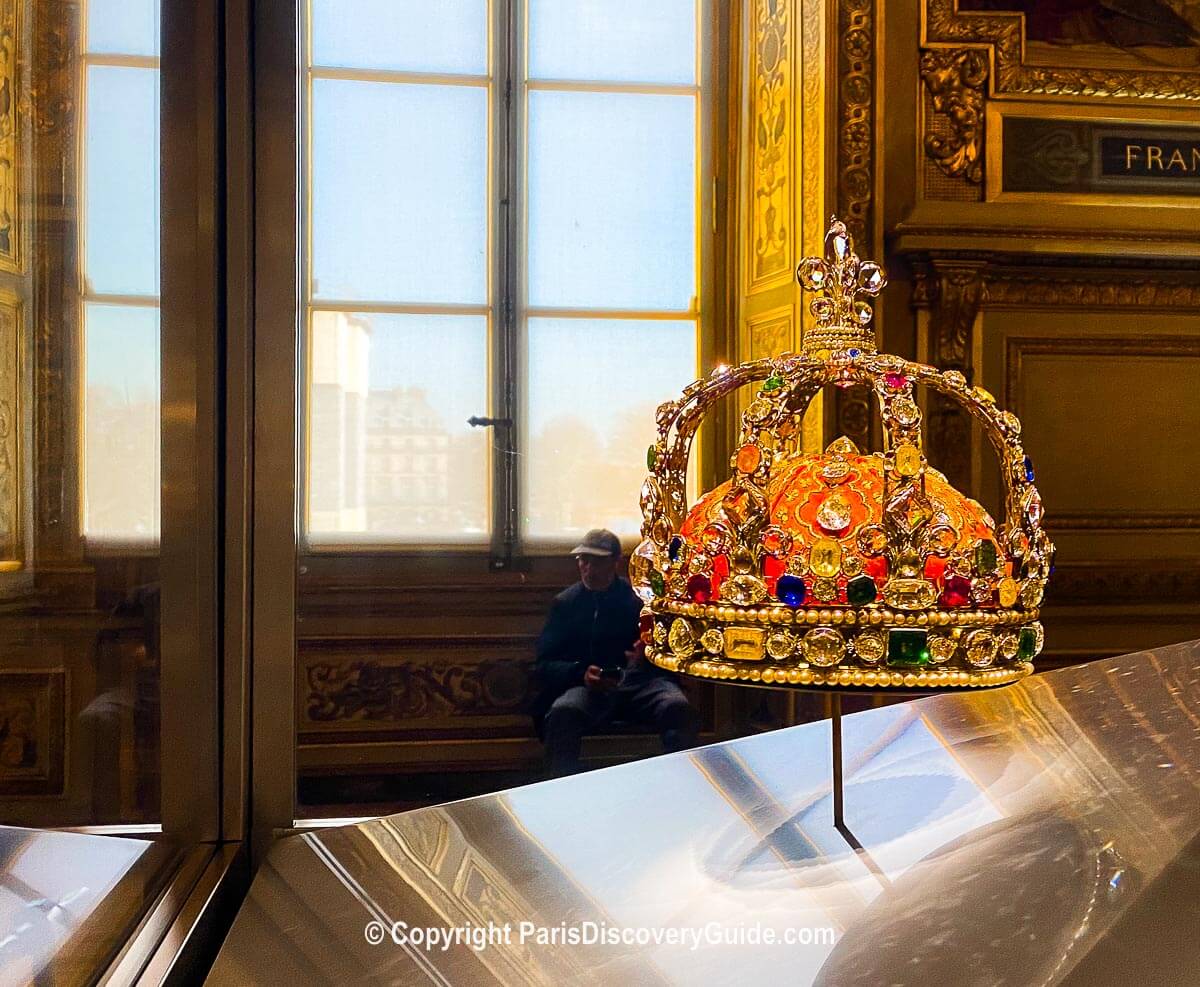
As brilliant as the gems are, the gallery almost outshines them.
Most of the longer tours take you to see this room and the jewels in it - not a quick stop because there's so much to absorb.
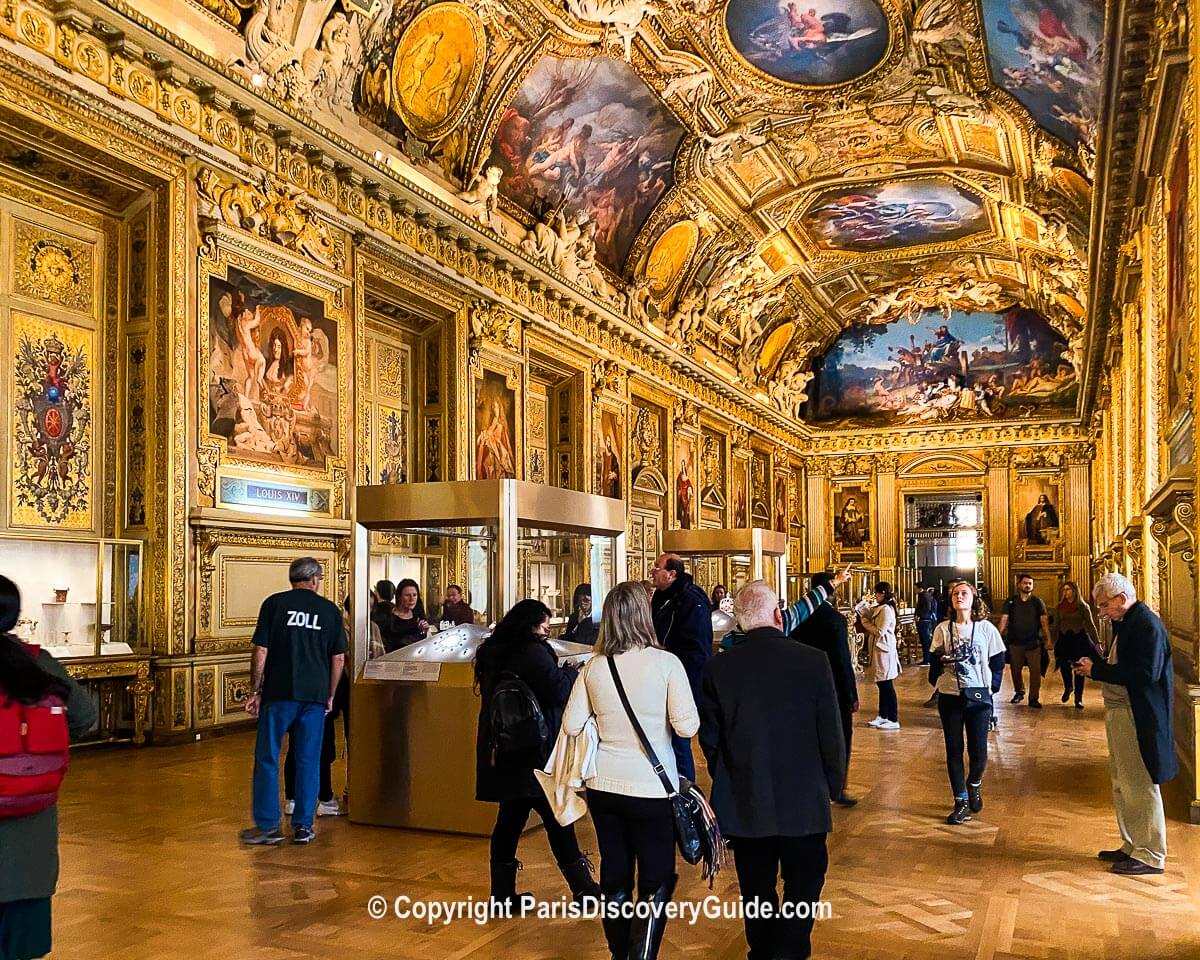
Napoleon III's Apartments
Last but certainly not least, another spectacular attraction normally included only with the longer tours - because it's not a quick visit - is the dazzling series of rooms known as Napoleon's Apartments.
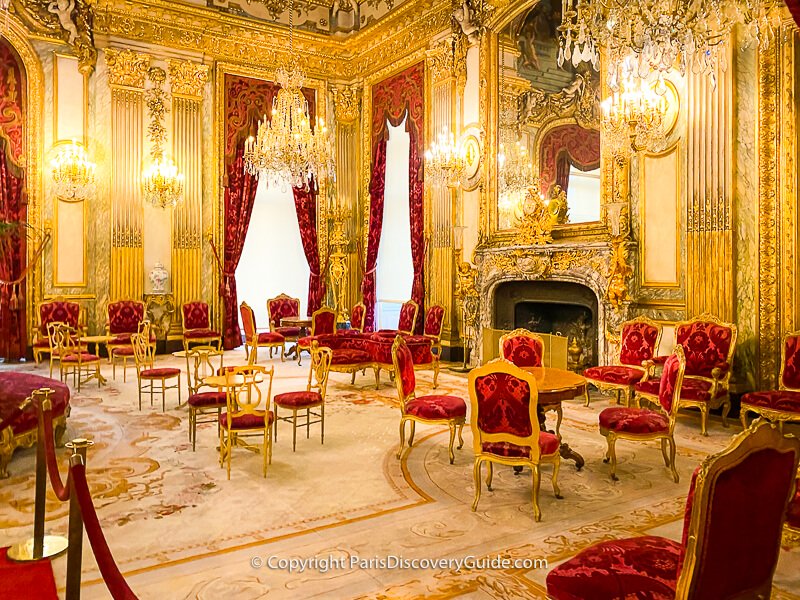
Contrary to what you might believe from the name, Napoleon III never lived here himself but he did order the rooms created as part of his major expansion of the Louvre's Richelieu Wing in the 1850s. His Minister of State used the rooms to entertain and no doubt impress visiting heads of state.
The rooms practically drip with gold, crimson, mirrors, and sparkling crystal chandeliers. Elaborately painted ornate ceilings complete the look.
The apartments outshine even the over-the-top opulence of Louis XIV's Versailles Palace - but then Louis was a mere king whereas Napoleon III was France's Second Emperor, like his famous uncle, Napoleon Bonaparte, who was the first to bestow this title upon himself.
Incidentally, that's why this ornate, over-the-top style, which you can also see at the similarly dazzling Palais Garnier (Paris Opera House), is called "Second Empire."
More about top attractions to see in Paris's 1st Arrondissement
Your admission ticket from most guided tours good for the rest of the day, so you're welcome to explore the former palace on your own.
What Else Can You Do & See in the Louvre?
Take a Break from Art: Tea on a Terrace
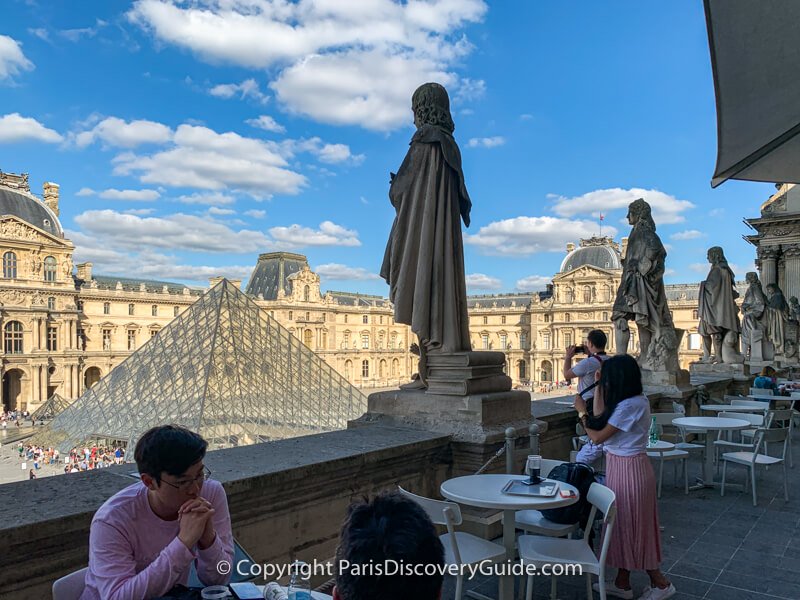
Although the Louvre has a number of cafes and places to eat scattered throughout its three wings, Café Mollien offers a special experience because of its statue-lined outdoor terrace overlooking the Pyramid.
To find Café Mollien, look for a large elaborate staircase at the end of the French Paintings Gallery and walk up. You'll spot Café Mollien on your right.
The cafe offers light snacks similar to what you'd find in a bakery - pastries, slices of quiche, and salads - along with hot beverages, water, soft drinks, beer, and wine. But what makes it fantastic is the terrace seating overlooking the rest of the Louvre, its courtyard with the glass pyramid, and in the distance, Tuileries Garden.
The terrace is the perfect place to relax and enjoy the restorative powers of, for example, a cup of tea and a slice of lemon tart.
Cy Twombly Ceiling in the Salle des Bronzes
The magnificent blue Cy Twombly ceiling in the Salle des Bronzes located in the Sully Wing almost overshadows the 1,000 or so fascinating bronze objects normally on display here.
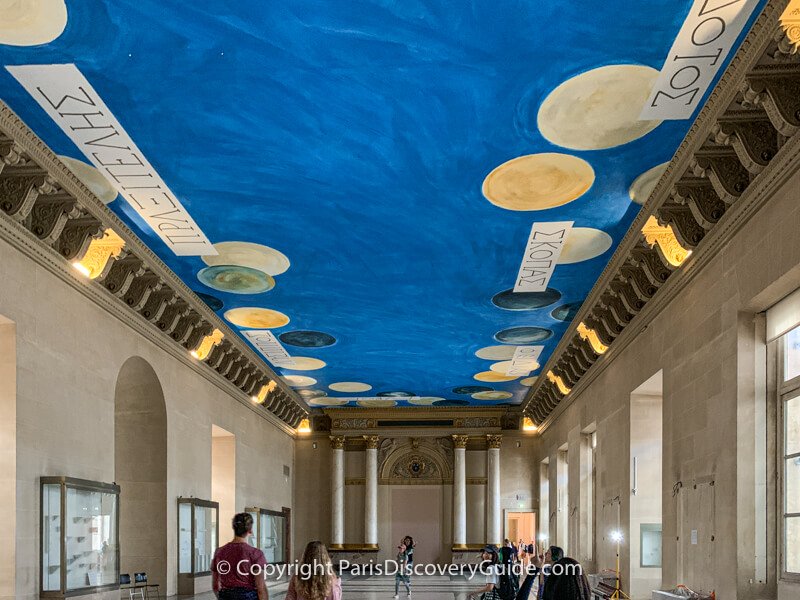
The striking blue ceiling reflects an initiative by the Louvre to incorporate contemporary art and was created in 2010 by Cy Twombly, the first American artist to ever be asked to create a permanent installation in the museum. The white strips along the edges contain the names (in Greek) of seven renowned Greek sculptors from the Classic period.
Decorative Arts Galleries
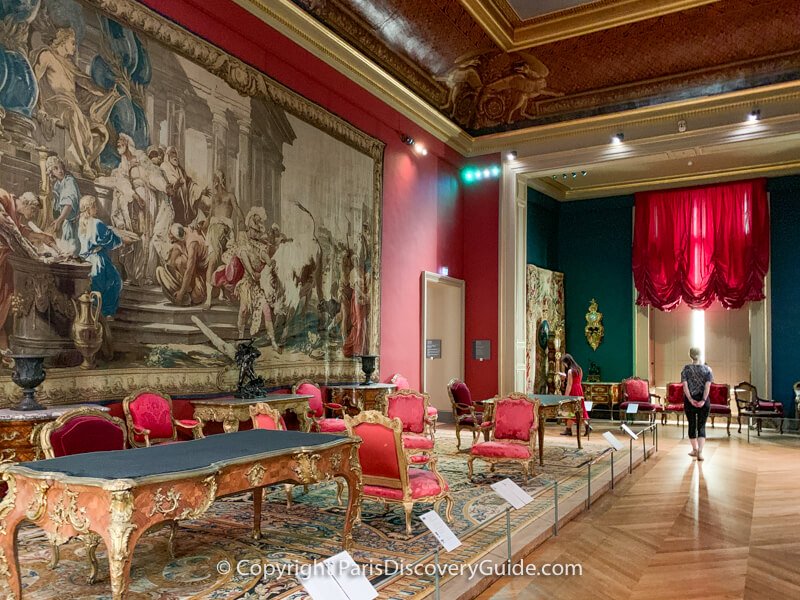
If you're interested in visiting the Louvre's Department of Decorative Arts, here's what you should know: it is immense. It occupies the entire second floor of the Richelieu Wing and part of the Sully Wing including the Apollo Gallery, and has seven sections devoted to specific periods of French history from the Middle Ages through the 19th century.
The Napoleon III Apartments in the Napoleon I to Napoleon III Galleries are the most popular with visitors due to their over-the-edge extravagance involving vast quantities of crimson velvet, crystal chandeliers, and gold, but there's much, more more to see beyond the apartments. On a typically day, you'll have this area mostly to yourself.
The Medieval to Renaissance Galleries are a close second in popularity, and a "must" if you love tapestries.
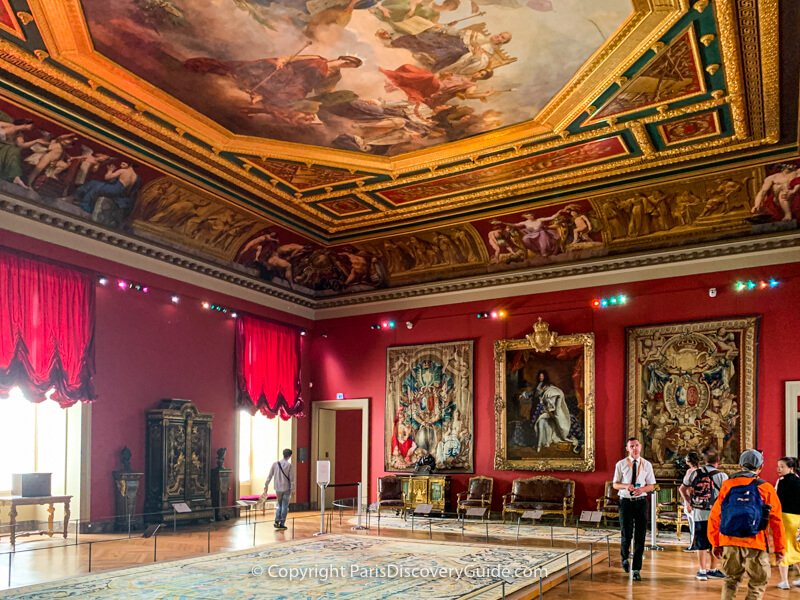
Another fantastic section contains the Louis XIV to the Revolution Galleries. Wander through about the dozen or so sumptuously elegant rooms to immerse yourself in French aristocratic life in the 17th and 18th centuries.
Islamic Art Galleries in the Denon Wing
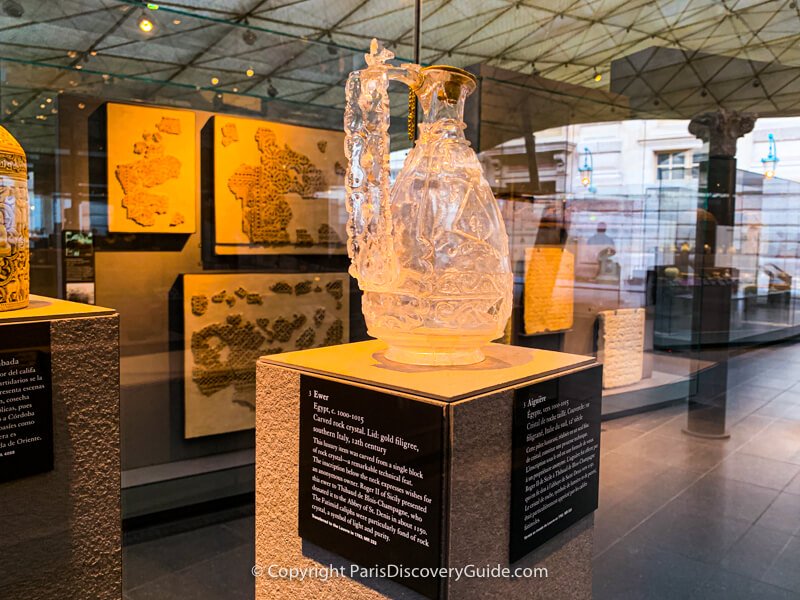
The Islamic Art Galleries opened only in 2012, and are the Louvre's new installation. The galleries occupy two lower floors in the Denon Wing, under an undulating golden roof of glass triangles that moves with the wind and filters in outdoor light. You can see the neoclassical design of the museum's Cour Visconti Courtyard through the mostly-glass walls.
The 2,500 or so objects on display here span a dozen centuries (7th through 19th) and cover a wide swath of regions from Spain to India. The collection is organized according to period and location, and is still growing.
Trying to see everything all at once would be overwhelming. After wandering around for a bit, a good strategy is to focus on displays devoted to art from a specific region and time period - for example, Egypt and North Africa created about a thousand years ago.
Pavillon de l'Horloge ("The Clock Pavilion)
Before the Louvre was an art museum, it was the palace for French kings and queens - and before that, it was a fortified castle during medieval times.
So our last suggestion for what to see inside the Louvre after your tour ends is the fascinating Pavillon de l'Horloge on Level 0 of the Sully Wing where you can see where the museum begin - or at least, its 12th century foundations.
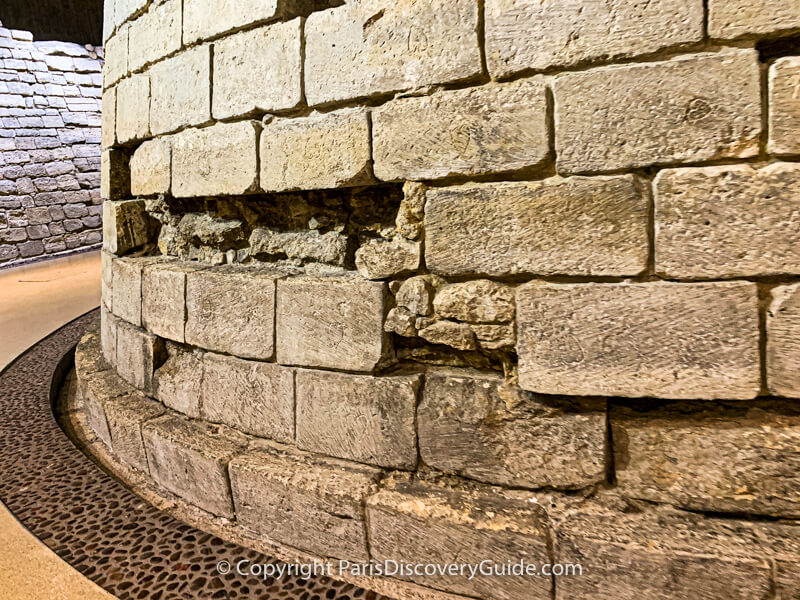
The Pavillon de horology contains the remains of the moat that once surrounded the medieval fortress built by Philippe-Auguste from 1190-1202.
After being filled in to make way for renovations in 1528, the moat was forgotten until the mid-1980s when a major archaeological excavation undertaken in preparation for constructing the glass pyramids uncovered it, along with hundreds of thousands of objects tossed into the moat through the centuries.
Recent renovations have opened up this area to visitors and in addition to walking around the foundations and moat walls of the original fortress, you can view a number of fascinating displays showing the evolution of the Louvre from fortress to the world's largest art museum. You can easily spend a couple of hours in this gallery.
Something special to look for: on many of the stones, you can see carvings of small symbols such as hearts, squares, triangles, and other marks. These are the individual "signatures" carved into the stones by the original stonemasons who constructed the moat - very cool to see over 800 years later!
The Perfect Ending to Your Louvre Tour: Tuileries Garden
Once you leave the museum, there's one more part of the Louvre complex you may want to visit if you have time: Tuileries Garden, located to the west of the museum toward Place de la Concorde.
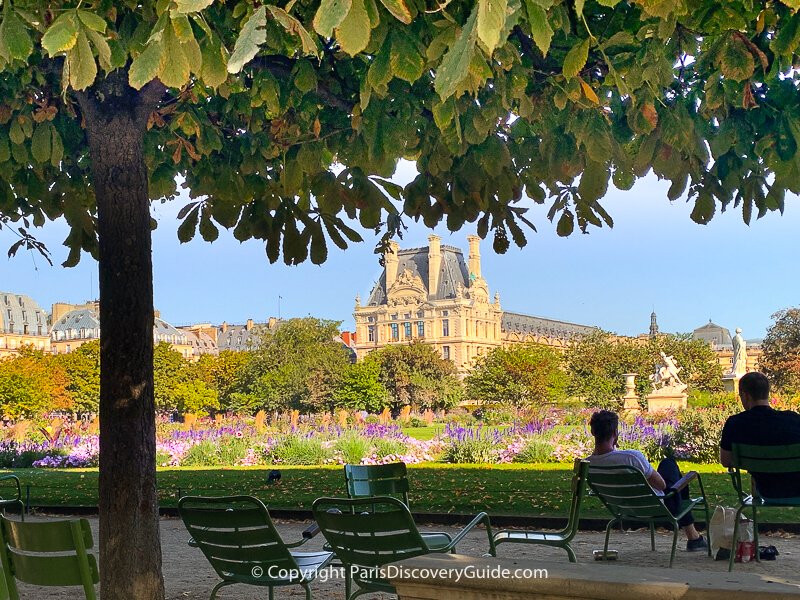
Jardin des Tuileries (Tuileries Garden) dates back to 1564 when Catherine de Medici created it on the site of an old tile factory (tuileries is the French word for tiles) after her husband, King Henry II, died after being injured during a jousting match.
Today, Tuileries Garden is open to the public free of charge and is one of Paris's loveliest parks with pools, fountains, numerous statues, plenty of comfortable seating, and lush flower gardens. It's the perfect spot to rest your feet after hours of walking around the Louvre - or anytime!
How to Choose the Best (for You) Louvre Museum Guided Tour
- Decide what you want - Small (6 or less) group or large group? Public tour (agenda will be set by the tour guide) or private tour (tour guide will typically customize the itinerary based on your interests)? Do you want to be able to cancel (with full refund) or reschedule if necessary?
- Choose a less crowded day if possible, especially during peak seasons. The Louvre is closed on Tuesdays; Mondays and Wednesdays are usually the most crowded weekdays, and Saturdays and Sundays are even busier. So schedule your tour for a Thursday or Friday if possible. But if you can't, don't worry - tour guides are experts at dodging crowds.
- Want to explore the Louvre on your own after your tour ends? The Louvre closes at at 9:45pm on Wednesdays and Fridays and 6pm on other days - so make sure your tour ends early enough to allow you the amount of time you want. If not, look for another tour.
- Book through a booking agency such as Get Your Guide or Viator that has 24x7 customer support staff who speak your language - This makes canceling or rescheduling a booking, asking a question, or getting other help or information much easier!
- Do you have any questions about the tour? Call the customer service number and ask!
- Read online reviews carefully - No tour is ever going to get 100% 5-star ratings, assuming they have more than just a handful of reviews - but you might want to give preference to tours that get 4 stars or better.
- Are you bringing your kids on the tour? If so, book a family-oriented tour designed to keep kids entertained and engaged, which you can find for many venues including the Louvre. Your kids will absorb more information with this approach and even more important, be much happier - and so will you.
Recommended Tours - Choose the One that's Best for You
- Louvre Masterpieces Tour with Reserved Tickets - Most popular choice
- Louvre Museum Skip-the-Line Guided Tour - Small group tour
- Priority Access with Host - Direct to Mona Lisa - Plus, you can explore on your own
- Louvre Museum Tour with Mona Lisa & Iconic Masterpieces - Highly rated larger group experience
- Must-Sees of the Louvre Museum: 1.5 Hour Guided Tour - Good for when you don't have much time - usually offered in both large-group and small-group formats
- Paris Louvre: 2-Hour Private Tour for Families & Children - Start with the Mona Lisa and then continue on to see other special exhibits in a fun and family-friendly manner
- Louvre Museum Skip-the-Line Access Private Guided Tour - For a VIP type experience
Or book a priority entrance ticket or use a discount pass such as the Museum Pass and explore on your own.
How to See Special Exhibitions at the Louvre
Most Louvre tours do not include special exhibitions - but the good news is that you can see these on your own after your tour. Almost all are free.
Check out the major current and upcoming Louvre special exhibitions
Where to Stay near the Louvre
Near the Louvre Museum in the historical heart of Paris, you'll find so many other wonderful things to explore and experience - more famous museums and monuments, the Paris Opera House (Palais Garnier), world-class shopping in Parisian boutiques along Rue Saint-Honoré, fabulous cafes and restaurants.
This is a fantastic part of the city to stay in, so if you're looking for a hotel or short-stay apartment close to the Louvre, check out our recommendations.
Map Showing More Paris Hotels & Apartments
Want to see more Paris hotels and apartment rentals? Use this hotel map from Booking.com to find accommodations in all prices ranges based on your travel dates, and make your reservations:
Booking.comCheck out the newest Paris hotels
More Articles about Top Attractions in Paris
- Top 10 Paris attractions - The city’s most iconic places and sights!
- Paris Museum Pass - How much money and time can you save with it?
- Skip the Line Tickets - How to get fast entry to top Paris attractions
- Easy Day Trips from Paris to Versailles, Giverny, D-Day Beaches, Disneyland, & more
- Where to go for spectacular views of the Paris skyline
- Find out about Île de la Cité's medieval masterpieces in the heart of Paris




